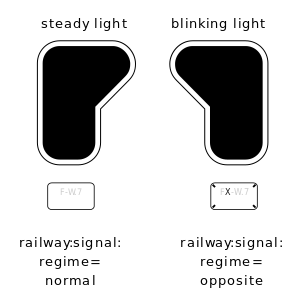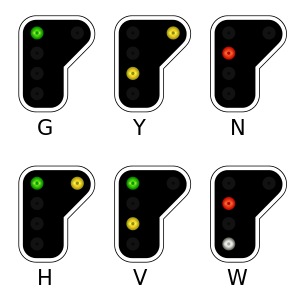User:Eimai/Railway
Introduction
Let's try to come up with a tagging scheme for railway signals in Belgium...
Main problem is finding a good English translation for all the terminology.
- railway=signal
- railway:signal:ruleset=BE to define this is for the Infrabel network in Belgium.
Signals
The terminology in Belgium is that signals have lights, and signs don't, so this section is just for signals defined according to Belgian rules
General features

- railway:signal:direction=forward or railway:signal:direction=backward: if this signal is for the direction the way the node is on is going (forward), or the opposite direction (backward)
- railway:signal:position=right or railway:signal:position=left if the signal is not at the default side of the track. The position is relative to the intrinsic direction of the way in OpenStreetMap.
- ref=* for the signal name if it has one (e.g. A121, DX-K.5, k123-l.10) (note that there's a difference between uppercase and lowercase, and the dashes and periods are important)
- railway:signal:regime=normal or railway:signal:regime=opposite if you need to define what regime the signal is (normaalspoor, tegenspoor). Small, simplified and buffer stop signals can only be normal regime and don't need this tag.
Big stop signals (groot stopsein)
Can be normal regime or opposite regime. Normal regime signals are by default on the left side of the track, but can be on the right. Opposite regime signals can only be at the right side of the track.
- railway:signal:type=big_stop_signal
- railway:signal:managed=yes/no if the signal is managed (beheerd) or not.
- railway:signal:big_stop_sign_type=I for the big stop signals of type I. These signals cannot show all aspects.
- railway:signal:passing_at_danger=light/crown/two_red_bands/two_red_bands_with_light for features on the signal that can give permission to pass the signal at danger (resp. overschrijdingslicht, overschrijdingkroon, kast met twee rode banden, kast met twee rode banden en overschrijdingslicht)
- railway:signal:big_signal_speed_sign=4 for a fixed sign that imposes a speed limit at that signal (snelheidsbord van een groot stopsein)
- railway:signal:warning_signal_speed_sign=6 for the white triangular sign that gives information about the speed at the next signal when the aspect is green yellow horizontal (snelheidsbord van een verwittigingssein)
- railway:signal:down_gradient=
i>12or railway:signal:down_gradient=i>=18for when steep down gradients are announced on the signal by separate signs. - railway:signal:etcs_sign=entry or railway:signal:etcs_sign=exit
Aspects:
- G = green, Y = two yellow, H = green + yellow horizontally, V = green + yellow vertically, W = red + white. The stop aspect is implied by the signal type. If the signal can only show the stop aspect, use N.
- Top panel: V = chevron, U = cul-de-sac, CAB, # = yellow number (the symbol, not the actual number)
- Bottom panel: <number> = white number, pk, $ = one or more letters
- The yellow number on the top panel is either the same as the white number on the next panel for the horizontal aspect and it then doens't have to be specified.
- For a green yellow vertical aspect with a yellow number on the top panel, which is always followed by a signal with green yellow horizontal aspect, specify the numbers as such: #(12>9,10) (12 on first signal when the next signal shows 9, 10 on first signal when the next signal shows the lowest possible number it has)
- Yellow and white numbers can be enclosed in a square, in that case add a ° behind the number like 4°
- Simple aspects then consist of a <list of main aspects>(<top panel>)(<bottom panel>). For example, a signal can show green and two yellow aspects, with a chevron and a white number 6, then this becomes: GY(V)(6). Without the chevron that becomes GY(6).
- Signals show a different sets depending on the route that's set, and often the signal is linked to the next signal so it gives information about the next signal. Linked signals can be added between square brackets. By convention you add these in lowercase instead of uppercase.
- Green yellow vertical aspects are linked to the next two signals, add this like [a123+a135], and if a section is too short to stop or to slow down to a certain speed, add this like [(0)a123] where the (0) defines the highest speed at which the vertical aspect has to be shown
Examples:
- YW: signal only opens in two yellow or red-white, no information about the next signal
- GY[a123]: signal shows green or two yellow aspect, and is linked to the next signal A123
- GY[a123, b987]: signal shows green or two yellow aspects, two linked signals (so there are multiple routes from this signal)
- W;Y(U): signal shows red-white, or a two yellow with U on top. Typical for dead-end tracks in railway stations.
- GY(6)[d.10];Y(4)
- GYV[a123+e.3(4)]
- GYHV[(4)px.21+e.21];GY(4)[j6.21,rx.21];GY(V)(4)[k6.21,qx.21]
- GY[a010,a436];GY(V)[bx010,bx436]
Warning signals (verwittigingssein)
These signals will only give information about the next signal, but can't show a stop aspect.
Small stop signals (klein stopsein)
Can only be normal regime. By default on the left side of the track but can be on the right. Only for trains driving in small movement and ignored by trains in big movement. Always at ground level.
- railway:signal:type=small_stop_signal
- railway:signal:aspect=N if the signal can only show a stop aspect
Simplified stop signals (vereenvoudigd stopsein)
Can only be normal regime. By default on the left side of the track but can be on the right. Can be at normal height or at ground level.
- railway:signal:type=simplified_stop_signal
- railway:signal:aspect=N if the signal can only show a stop aspect
Buffer stop signals (stootboksein)
Signals at the end of a track. Almost the same as buffer stop signs (which don't have a light in them), but signals can be encountered in big movement as well.
Repeater signals (herhaler)
These signals will display if the next signal is open without any restriction or not, used when the main signal is obstructed and cannot be well observed.
Signs
Speed signs
- railway:signal:type=speed_sign
- railway:signal:speed_sign:type=a,b,c,ac,bc,r,s,t,rt,st: aankondigingsbord (a, r), oorsprongsbord (b, s), refertebord (c, t), eindezonebord groen met gele boord (ac, rt), eindezonebord geel met groene boord (bc, st), abc are for normal regime, rst are for opposite regime
- railway:signal:speed_sign:speed=12: speed in tens of km/h
- railway:signal:speed_sign:additional=ME-MZ, HKM, HKM-G, HST/TGV, pk, V, PLAN, etc. for additional information about what trains the speed sign applies.
Line sign
- railway:signal:type=line_sign for signs that tell what railway line this track leads to.
- railway:signal:line_sign:ref=59/1

